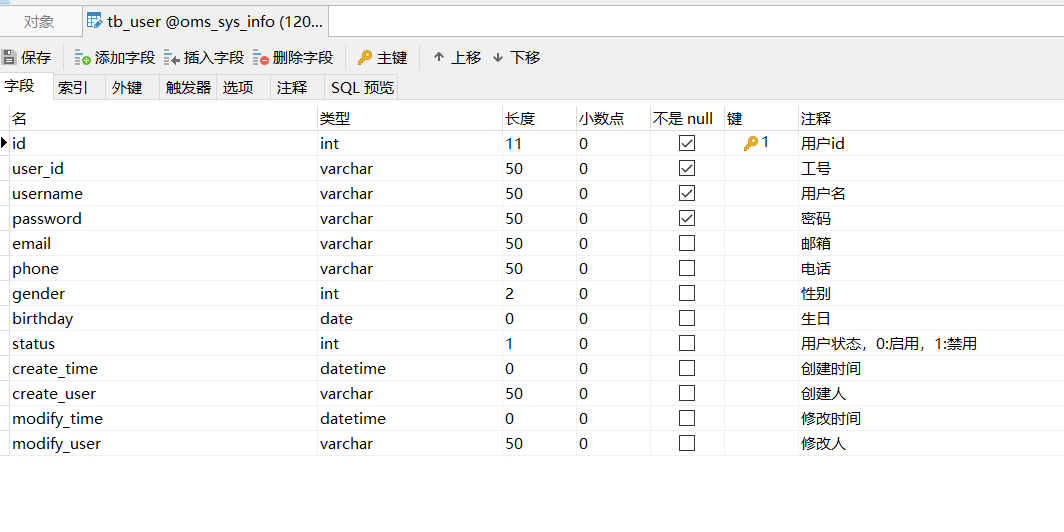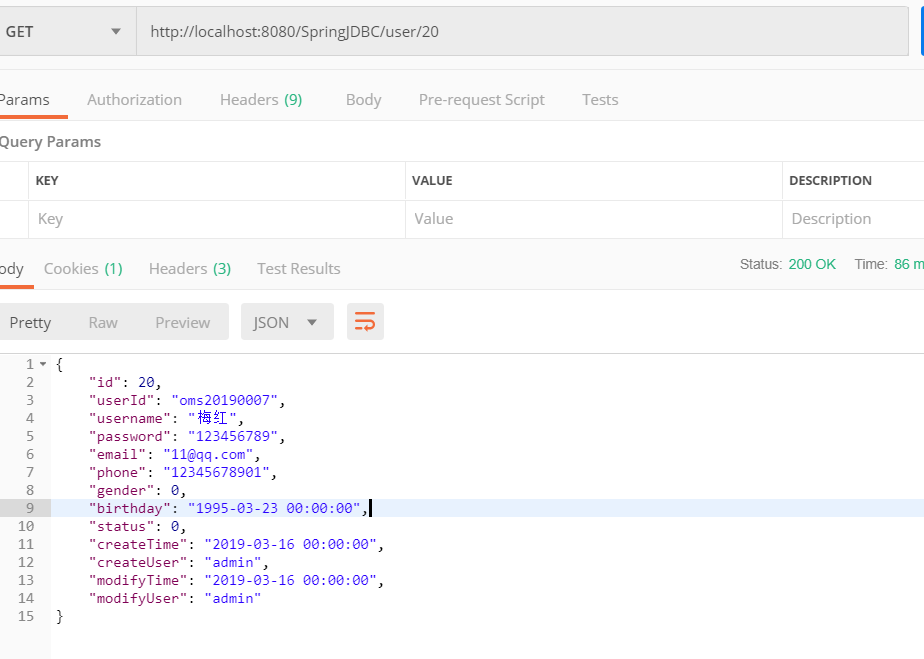《Spring in action 4》(八)Spring和JDBC操作数据库
Spring和JDBC操作数据库
使用JNDI配置数据源
- 在Tomcat服务器的conf下的context.xml 配置数据源
<Resource
name="jdbc/mysql"
auth="Container"
type="javax.sql.DataSource"
maxActive="20"
maxIdle="5"
maxWait="10000"
username="root"
password="root"
driverClassName="com.mysql.jdbc.Driver"
url="jdbc:mysql://120.79.167.xx:3306/oms_sys_info?useUnicode=true&characterEncoding=utf-8"/>
- 使用xml或是Java类配置
配置jndi这种情况使用xml可能更加简单。
<jee:jndi-lookup id="dataSource" jndi-name="jdbc/mysql" resource-ref="true"/>
- 使用Java配置类
@Configuration
public class DataSourceConfig {
@Bean
public JndiObjectFactoryBean dataSource(){
JndiObjectFactoryBean bean = new JndiObjectFactoryBean();
bean.setJndiName("jdbc/mysql");
bean.setResourceRef(true);
bean.setProxyInterface(DataSource.class);
return bean;
}
@Bean
public JdbcTemplate jdbcTemplate(DataSource dataSource){
System.out.println(dataSource);
return new JdbcTemplate(dataSource);
}
}
使用JDNI方式访问数据库
1. POM依赖
<?xml version="1.0" encoding="UTF-8"?>
<project xmlns="http://maven.apache.org/POM/4.0.0" xmlns:xsi="http://www.w3.org/2001/XMLSchema-instance"
xsi:schemaLocation="http://maven.apache.org/POM/4.0.0 http://maven.apache.org/xsd/maven-4.0.0.xsd">
<modelVersion>4.0.0</modelVersion>
<groupId>com.ooyhao.spring</groupId>
<artifactId>spring-in-action-10-01</artifactId>
<version>1.0-SNAPSHOT</version>
<packaging>war</packaging>
<name>spring-in-action-10-01 Maven Webapp</name>
<url>http://www.example.com</url>
<properties>
<project.build.sourceEncoding>UTF-8</project.build.sourceEncoding>
<maven.compiler.source>1.7</maven.compiler.source>
<maven.compiler.target>1.7</maven.compiler.target>
</properties>
<dependencies>
<dependency>
<groupId>junit</groupId>
<artifactId>junit</artifactId>
<version>4.11</version>
<scope>test</scope>
</dependency>
<!--导入Servlet依赖-->
<dependency>
<groupId>javax.servlet</groupId>
<artifactId>javax.servlet-api</artifactId>
<version>4.0.1</version>
</dependency>
<!--导入SpringMVC依赖-->
<dependency>
<groupId>org.springframework</groupId>
<artifactId>spring-webmvc</artifactId>
<version>5.1.9.RELEASE</version>
</dependency>
<!--导入Jackson依赖-->
<dependency>
<groupId>com.fasterxml.jackson.core</groupId>
<artifactId>jackson-databind</artifactId>
<version>2.9.8</version>
</dependency>
<dependency>
<groupId>com.fasterxml.jackson.core</groupId>
<artifactId>jackson-annotations</artifactId>
<version>2.9.8</version>
</dependency>
<!--Junit测试依赖-->
<dependency>
<groupId>junit</groupId>
<artifactId>junit</artifactId>
<version>4.11</version>
<scope>test</scope>
</dependency>
<!--hibernate参数校验依赖-->
<dependency>
<groupId>org.hibernate.validator</groupId>
<artifactId>hibernate-validator</artifactId>
<version>6.1.0.Alpha3</version>
</dependency>
<!--整合Thymeleaf-->
<dependency>
<groupId>org.thymeleaf</groupId>
<artifactId>thymeleaf</artifactId>
<version>3.0.11.RELEASE</version>
</dependency>
<dependency>
<groupId>org.thymeleaf</groupId>
<artifactId>thymeleaf-spring5</artifactId>
<version>3.0.9.RELEASE</version>
</dependency>
<!-- druid数据源 -->
<dependency>
<groupId>com.alibaba</groupId>
<artifactId>druid</artifactId>
<version>1.1.20</version>
</dependency>
<dependency>
<groupId>org.springframework</groupId>
<artifactId>spring-jdbc</artifactId>
<version>5.1.6.RELEASE</version>
</dependency>
<dependency>
<groupId>com.mchange</groupId>
<artifactId>c3p0</artifactId>
<version>0.9.5.2</version>
</dependency>
<dependency>
<groupId>com.mchange</groupId>
<artifactId>mchange-commons-java</artifactId>
<version>0.2.11</version>
</dependency>
<dependency>
<groupId>mysql</groupId>
<artifactId>mysql-connector-java</artifactId>
<version>5.1.48</version>
</dependency>
</dependencies>
</project>
2. Tomcat context.xml
<Resource
name="jdbc/mysql"
auth="Container"
type="javax.sql.DataSource"
maxActive="20"
maxIdle="5"
maxWait="10000"
username="root"
password="root"
driverClassName="com.mysql.jdbc.Driver"
url="jdbc:mysql://120.79.167.xx:3306/oms_sys_info?useUnicode=true&characterEncoding=utf-8"/>
我们使用JDNI来配置数据源时,我们需要在tomcat下的conf目录下的context.xml添加对应的数据源,不同的数据源所配置的信息是不一样,这里是Tomcat默认的dbcp数据源,后面有修改为c3p0的案例。
3. jdni.xml
<?xml version="1.0" encoding="UTF-8"?>
<beans xmlns="http://www.springframework.org/schema/beans"
xmlns:xsi="http://www.w3.org/2001/XMLSchema-instance"
xmlns:jee="http://www.springframework.org/schema/jee"
xsi:schemaLocation="http://www.springframework.org/schema/beans
http://www.springframework.org/schema/beans/spring-beans.xsd
http://www.springframework.org/schema/jee
http://www.springframework.org/schema/jee/spring-jee-4.0.xsd">
<jee:jndi-lookup id="dataSource" jndi-name="jdbc/mysql" resource-ref="true"/>
</beans>
jee标签,就是将tomcat的数据源引入到项目中,并且通过后面的DataSourceConfig中的@ImportResource注解将其注入到Ioc容器中。id就相当于是bean的id,而jndi-name就是对应前面到tomcat的context.xml中配置数据源的名字一致。
4. DataSourceConfig
@Configuration
@ImportResource(value = "classpath:jdni.xml")
public class DataSourceConfig {
@Bean
public JdbcTemplate jdbcTemplate(DataSource dataSource){
return new JdbcTemplate(dataSource);
}
}
这里主要是将xml配置文件引入到配置类中,因为配置jndi数据源,使用xml文件的形式更加简单一点(当然,java配置类的形式也是可以简单的实现),并且将数据源注入到JdbcTemplate,因为这一节我们简单使用Spring的JdbcTemplate来操作数据库。
5. InitWeb
public class InitWeb extends AbstractAnnotationConfigDispatcherServletInitializer {
@Override
protected Class<?>[] getRootConfigClasses() {
return new Class[]{
RootConfig.class
};
}
@Override
protected Class<?>[] getServletConfigClasses() {
return new Class[]{
ServletConfig.class
};
}
@Override
protected String[] getServletMappings() {
return new String[]{
"/"
};
}
}
InitWeb我们应该非常熟悉了,其实就是替代了原来的Web.xml文件的角色。
6. ServletConfig
@Configuration
@EnableWebMvc
@ComponentScan(basePackages = "com.ooyhao.spring.**.controller")
public class ServletConfig implements WebMvcConfigurer {
@Override
public void configureDefaultServletHandling(
DefaultServletHandlerConfigurer configurer) {
configurer.enable();
}
}
ServletConfig文件就是相当于之前的SpringMVC.xml。这里开启了对静态资源的访问。
7. RootConfig
@ComponentScan(basePackages = "com.ooyhao.spring",useDefaultFilters = true,excludeFilters = {
@ComponentScan.Filter(type = FilterType.ANNOTATION,value = Controller.class),
@ComponentScan.Filter(type = FilterType.ANNOTATION,value = RestController.class)
})
public class RootConfig {}
RootConfig则相当于是配置文件形式下的applicationContext.xml文件。
8. TbUser
package com.ooyhao.spring.bean;
import com.fasterxml.jackson.annotation.JsonFormat;
import java.io.Serializable;
import java.util.Date;
/**
* 描述:
* 类【TbUser】
*
* @author ouYangHao
* @create 2019-09-10 15:49
*/
public class TbUser implements Serializable {
private Integer id;
private String userId;
private String username;
private String password;
private String email;
private String phone;
private Integer gender;
@JsonFormat(pattern = "yyyy-MM-dd HH:mm:ss",timezone = "GMT+8")
private Date birthday;
private Integer status;
@JsonFormat(pattern = "yyyy-MM-dd HH:mm:ss",timezone = "GMT+8")
private Date createTime;
private String createUser;
@JsonFormat(pattern = "yyyy-MM-dd HH:mm:ss",timezone = "GMT+8")
private Date modifyTime;
private String modifyUser;
public TbUser() {
}
public TbUser(Integer id, String userId, String username, String password, String email, String phone, Integer gender, Date birthday, Integer status, Date createTime, String createUser, Date modifyTime, String modifyUser) {
this.id = id;
this.userId = userId;
this.username = username;
this.password = password;
this.email = email;
this.phone = phone;
this.gender = gender;
this.birthday = birthday;
this.status = status;
this.createTime = createTime;
this.createUser = createUser;
this.modifyTime = modifyTime;
this.modifyUser = modifyUser;
}
public Integer getId() {
return id;
}
public void setId(Integer id) {
this.id = id;
}
public String getUserId() {
return userId;
}
public void setUserId(String userId) {
this.userId = userId;
}
public String getUsername() {
return username;
}
public void setUsername(String username) {
this.username = username;
}
public String getPassword() {
return password;
}
public void setPassword(String password) {
this.password = password;
}
public String getEmail() {
return email;
}
public void setEmail(String email) {
this.email = email;
}
public String getPhone() {
return phone;
}
public void setPhone(String phone) {
this.phone = phone;
}
public Integer getGender() {
return gender;
}
public void setGender(Integer gender) {
this.gender = gender;
}
public Date getBirthday() {
return birthday;
}
public void setBirthday(Date birthday) {
this.birthday = birthday;
}
public Integer getStatus() {
return status;
}
public void setStatus(Integer status) {
this.status = status;
}
public Date getCreateTime() {
return createTime;
}
public void setCreateTime(Date createTime) {
this.createTime = createTime;
}
public String getCreateUser() {
return createUser;
}
public void setCreateUser(String createUser) {
this.createUser = createUser;
}
public Date getModifyTime() {
return modifyTime;
}
public void setModifyTime(Date modifyTime) {
this.modifyTime = modifyTime;
}
public String getModifyUser() {
return modifyUser;
}
public void setModifyUser(String modifyUser) {
this.modifyUser = modifyUser;
}
@Override
public String toString() {
return "TbUser{" +
"id=" + id +
", userId='" + userId + '\'' +
", username='" + username + '\'' +
", password='" + password + '\'' +
", email='" + email + '\'' +
", phone='" + phone + '\'' +
", gender=" + gender +
", birthday=" + birthday +
", status=" + status +
", createTime=" + createTime +
", createUser='" + createUser + '\'' +
", modifyTime=" + modifyTime +
", modifyUser='" + modifyUser + '\'' +
'}';
}
}
9. UserService
package com.ooyhao.spring.service;
import com.ooyhao.spring.bean.TbUser;
import org.springframework.beans.factory.annotation.Autowired;
import org.springframework.jdbc.core.JdbcTemplate;
import org.springframework.jdbc.core.RowMapper;
import org.springframework.stereotype.Service;
import java.sql.Date;
import java.sql.ResultSet;
import java.sql.SQLException;
/**
* 描述:
* 类【UserService】
*
* @author ouYangHao
* @create 2019-09-10 15:55
*/
@Service
public class UserService {
@Autowired
private JdbcTemplate jdbcTemplate;
public TbUser findById(Integer id) {
TbUser tbUser = jdbcTemplate.queryForObject("select * from tb_user where id = ? ",
new Object[]{id},
new RowMapper<TbUser>() {
@Override
public TbUser mapRow(ResultSet resultSet, int i) throws SQLException {
int id = resultSet.getInt("id");
String userId = resultSet.getString("user_id");
String username = resultSet.getString("username");
String password = resultSet.getString("password");
String email = resultSet.getString("email");
String phone = resultSet.getString("phone");
int gender = resultSet.getInt("gender");
Date birthday = resultSet.getDate("birthday");
int status = resultSet.getInt("status");
Date createTime = resultSet.getDate("create_time");
String createUser = resultSet.getString("create_user");
Date modifyTime = resultSet.getDate("modify_time");
String modifyUser = resultSet.getString("modify_user");
TbUser user = new TbUser();
user.setId(id);
user.setUserId(userId);
user.setUsername(username);
user.setPassword(password);
user.setEmail(email);
user.setPhone(phone);
user.setGender(gender);
user.setBirthday(birthday);
user.setStatus(status);
user.setCreateTime(createTime);
user.setCreateUser(createUser);
user.setModifyUser(modifyUser);
user.setModifyTime(modifyTime);
return user;
}
});
return tbUser;
}
}
这里使用了Spring的JdbcTemplate来操作数据库,这里只是简单的使用了一下,如果使用,可以进一步研究。
10. UserController
package com.ooyhao.spring.controller;
import com.ooyhao.spring.bean.TbUser;
import com.ooyhao.spring.service.UserService;
import org.springframework.beans.factory.annotation.Autowired;
import org.springframework.web.bind.annotation.PathVariable;
import org.springframework.web.bind.annotation.RequestMapping;
import org.springframework.web.bind.annotation.RestController;
import javax.naming.NamingException;
/**
* 描述:
* 类【UserController】
*
* @author ouYangHao
* @create 2019-09-10 16:01
*/
@RestController
public class UserController {
@Autowired
private UserService userService;
@RequestMapping("/user/{id}")
public TbUser findById(@PathVariable("id") Integer id) throws NamingException {
return userService.findById(id);
}
}
11. 数据库数据

12. 测试结果

切换JDNI Tomcat默认的数据源
tomcat context.xml
<Resource
name="jdbc/mysql"
auth="Container"
factory="org.apache.naming.factory.BeanFactory"
type="com.mchange.v2.c3p0.ComboPooledDataSource"
maxPoolSize="20"
minPoolSize="5"
user="root"
password="root"
driverClass="com.mysql.jdbc.Driver"
jdbcUrl="jdbc:mysql://120.79.167.xx:3306/oms_sys_info?useUnicode=true&characterEncoding=utf-8"/>
Java配置类配置数据源
package com.ooyhao.spring.config;
import com.alibaba.druid.pool.DruidDataSource;
import com.mchange.v2.c3p0.ComboPooledDataSource;
import org.apache.commons.dbcp2.BasicDataSource;
import org.springframework.context.annotation.Bean;
import org.springframework.context.annotation.Configuration;
import org.springframework.context.annotation.Primary;
import org.springframework.jdbc.core.JdbcTemplate;
import javax.sql.DataSource;
import java.beans.PropertyVetoException;
/**
* 描述:
* 类【DataSourceConfig】
*
* @author ouYangHao
* @create 2019-09-10 15:26
*/
@Configuration
public class DataSourceConfig {
/*配置C3P0数据源*/
@Bean
@Primary
public DataSource dataSource1() throws PropertyVetoException {
ComboPooledDataSource dataSource = new ComboPooledDataSource();
dataSource.setMaxPoolSize(20);
dataSource.setMinPoolSize(5);
dataSource.setUser("root");
dataSource.setPassword("root");
dataSource.setDriverClass("com.mysql.jdbc.Driver");
dataSource.setJdbcUrl("jdbc:mysql://120.79.167.xx:3306/oms_sys_info?useUnicode=true&characterEncoding=utf-8");
return dataSource;
}
/*配置Druid数据源*/
@Bean
public DataSource dataSource2(){
DruidDataSource dataSource = new DruidDataSource();
dataSource.setMaxActive(20);
dataSource.setMaxWait(5);
dataSource.setMinIdle(5);
dataSource.setInitialSize(10);
dataSource.setUrl("jdbc:mysql://120.79.167.xx:3306/oms_sys_info?useUnicode=true&characterEncoding=utf-8");
dataSource.setUsername("root");
dataSource.setPassword("root");
dataSource.setDriverClassName("com.mysql.jdbc.Driver");
return dataSource;
}
/*配置DBCP数据源*/
@Bean
public DataSource dataSource3(){
BasicDataSource dataSource = new BasicDataSource();
dataSource.setMaxTotal(20);
dataSource.setMaxIdle(10);
dataSource.setInitialSize(5);
dataSource.setDriverClassName("com.mysql.jdbc.Driver");
dataSource.setUrl("jdbc:mysql://120.79.167.xx:3306/oms_sys_info?useUnicode=true&characterEncoding=utf-8");
dataSource.setMinIdle(5);
dataSource.setUsername("root");
dataSource.setPassword("root");
return dataSource;
}
@Bean
public JdbcTemplate jdbcTemplate(DataSource dataSource){
System.out.println(dataSource);
return new JdbcTemplate(dataSource);
}
}
总结:
这一节主要是介绍如何在Spring中操作数据库,而本节只是使用了Spring中的JdbcTemplate来操作数据库。同时本节包含了操作数据库一个重要的知识点--数据源。配置数据源包括了从服务器中获取,即通过JNDI配置数据源。或是使用Java配置类的形式类配置数据源。常用的数据源包括:DruidDataSource(Alibaba Druid)、BasicDataSource(DBCP)、ComboPooledDataSource(C3P0).
源码:
https://gitee.com/ooyhao/JavaRepo_Public/tree/master/Spring-in-Action/spring-in-action-10
最后
如果觉得不错的话,那就关注一下小编哦!一起交流,一起学习




